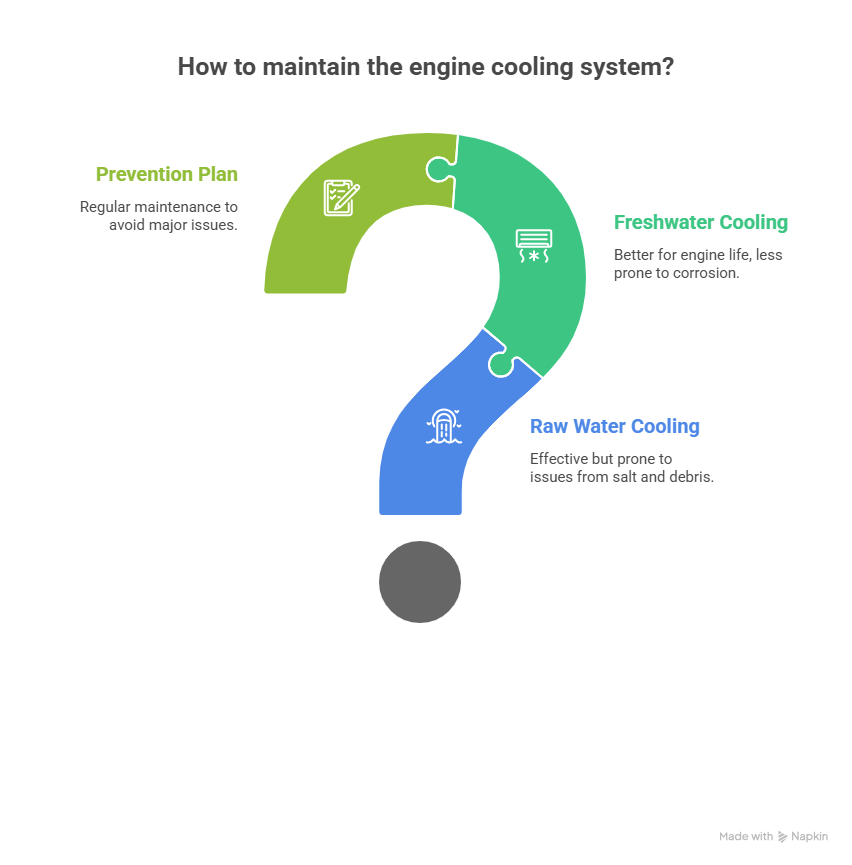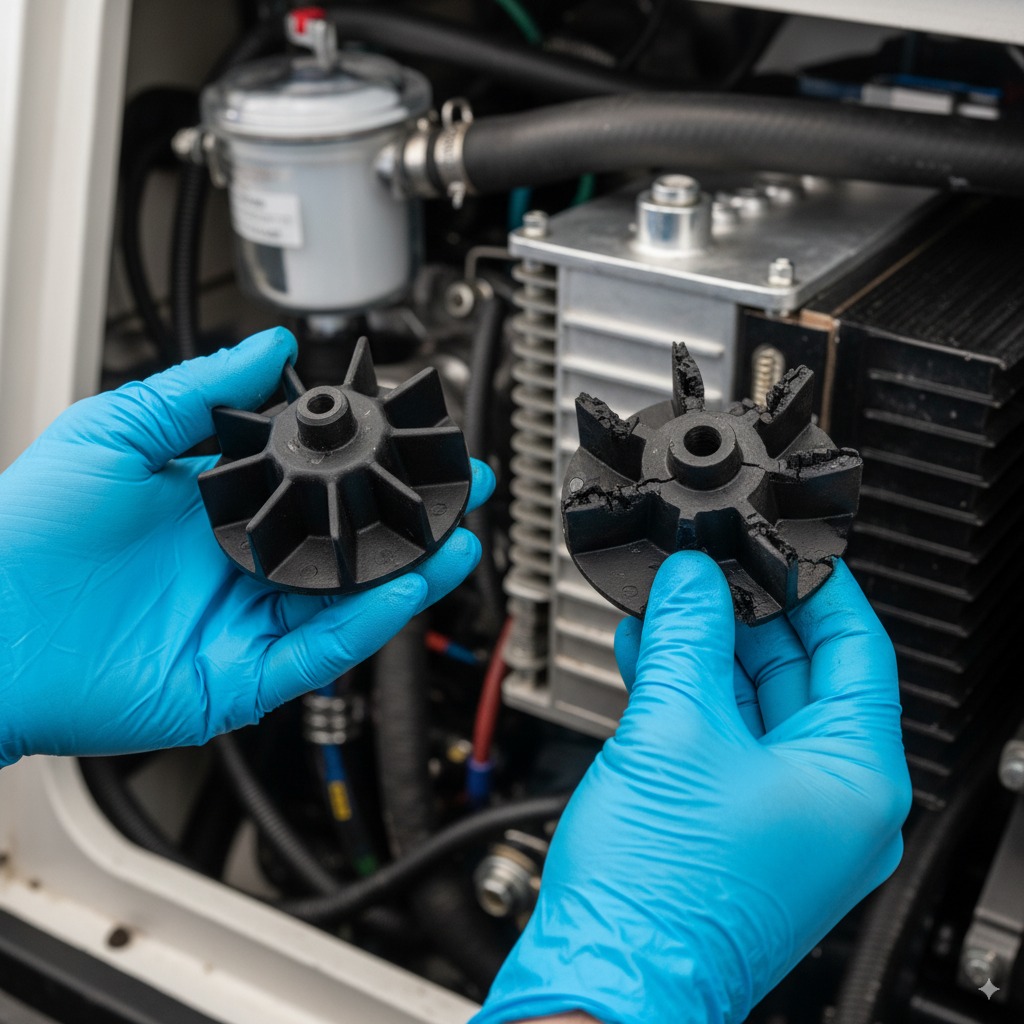That Blaring Alarm Off the Coast of Key Biscayne
I’ll never forget the call. It was a perfect Saturday afternoon, and a guy named Dave with a beautiful Sea Ray 340 was panicking. He was halfway to Stiltsville when that piercing alarm went off—overheating. His day was done. By the time I got to him, he was already calculating the cost of a new engine block. Luckily, it was just a shredded impeller and a clogged heat exchanger, but it was a stark reminder: when it comes to cooling system issues in marine engines, ignoring the whispers will lead to a scream.
I’m Alex, and I’ve been wrenching on boats in Miami for the better part of two decades. I can tell you that more outings are ruined and more engines are cooked by cooling problems than almost anything else. Your engine’s cooling system is the hardest working, least appreciated part of your boat. It’s what stands between you and a multi-thousand-dollar repair bill.
So, let’s talk about it, mechanic-to-boater. No complex jargon, just real-world advice on how to spot trouble, what to do about it, and how to prevent it from happening in the first place.
Table of Contents
How Your Engine Keeps Its Cool (Or Doesn’t)
First off, you need to know what you’re dealing with. Most boats have one of two systems:
- Raw Water (Open) Cooling: This is the simple one. The engine sucks up outside water (sea, lake, river), runs it through the engine block and manifolds to pick up heat, and spits it out the exhaust. It’s effective, but it’s like drinking straight from a dirty puddle. It brings in all the salt, sand, and sea life, which is a major cause of cooling system issues in marine engines.
- Freshwater (Closed) Cooling: This is more like your car. There’s a sealed loop of coolant (antifreeze) inside the engine. The raw water is still pulled in from the outside, but it only flows through a heat exchanger to cool the internal coolant. It’s much better for engine life because salt water never touches the inside of your engine block.
Regardless of the type, the key players are the same: a raw water pump with a rubber impeller, a thermostat, hoses, and (in a closed system) a heat exchanger. When you have problems, it’s almost always one of these culprits.
Spotting Trouble Before It Gets Serious
Your engine will usually give you warnings before it has a total meltdown. You just have to know what to look and listen for.
The Obvious Signs
An overheating alarm and a temp gauge pegged in the red are the last warnings you’ll get. Before that, you might notice:
- A Weak Telltale Stream: That little stream of water peeing out the side of your outboard? It should be strong and steady. If it’s sputtering or weak, you have a flow problem.
- Steam from the Exhaust: More steam than usual means the water exiting is too hot.
- Engine Performance Drop: An engine that’s running too hot will often feel sluggish.
I once had a client whose only symptom of impending doom was that his engine “felt tired.” Sure enough, his heat exchanger was almost completely blocked with scale. Catching these early signs is crucial for preventing major cooling system issues in marine engines.
Silent Killers: Blockages and Bad Impellers
The most common problem I see? A plastic bag sucked up against the raw water intake. It’s the first thing I check. After that, it’s the sea strainer—it’s supposed to catch grass and junk, and it needs to be cleaned out regularly.
But the #1 cause of sudden overheating is a failed impeller. That little rubber star inside your raw water pump is fragile. Run it dry for 30 seconds, and it’s toast. It can also just get old and brittle. When it fails, it often shreds, sending rubber pieces downstream to clog up cooling passages. That’s why if you find a damaged impeller, you HAVE to find all the pieces.

My Troubleshooting Checklist: What I Do First
When I get a call about an overheating engine, I run through a mental checklist. Here’s my process. First thing’s first: kill the power and let the engine cool down. Never work on a hot engine.
- Visual Inspection (The Obvious Stuff): I start at the source. Is the raw water intake clear? Is the sea strainer full of seaweed? Are any hoses collapsed, cracked, or leaking? You’d be surprised how many cooling system issues in marine engines are solved right here.
- Check the Impeller: This is almost always my next step. I pop the cover off the raw water pump and take a look. If the vanes are cracked, stiff, or missing, it gets replaced. No exceptions.
- Test the Thermostat: If the engine is running too hot OR too cold, the thermostat is a likely suspect. I’ll pull it and drop it in a pot of hot water with a thermometer. If it doesn’t open at the temperature stamped on it, it’s junk.
- Inspect the Heat Exchanger and Risers: In saltwater, these are magnets for corrosion and scale. I check the zinc anodes in the heat exchanger—if they’re gone, the exchanger itself is being eaten alive. I also pull the exhaust risers every few years. If the water passages are choked with rust, they need to be replaced. A clogged riser can cause overheating and even let water back into your engine.
Fixing the Problem: A Mechanic’s Quick Guide
To give you an idea of what you’re looking at, I put this table together based on common jobs I’ve done around Miami. Costs are just ballpark estimates, of course.
| Repair Job | DIY Difficulty | Average Cost (Parts + Labor) | My Quick Take |
|---|---|---|---|
| Impeller Replacement | Easy | $150 – $300 | Do this yourself. It’s the #1 preventative fix. |
| Thermostat Replacement | Easy | $100 – $250 | Another easy one. If in doubt, just replace it. |
| Cleaning Sea Strainer/Intake | Very Easy | Free (if you do it) | Should be part of your pre-start check. Every time. |
| Chemical Flush (Descaling) | Medium | $400 – $800 | Very effective, but follow the instructions exactly. |
| Exhaust Riser/Manifold Replacement | Hard | $1,500 – $4,000+ | Heavy, awkward work. Often better left to a pro. |
| Heat Exchanger Service/Replacement | Hard | $800 – $2,500+ | Can be complex. If it’s leaking, replace it. |
Dealing with cooling system issues in marine engines is often about knowing what you can tackle and when to call for backup.
How to Keep Your Engine Happy: The Prevention Plan
The best repair is the one you never have to make.
- Flush Your Engine: If you boat in saltwater, flush the engine with fresh water after every single trip. It’s the most important thing you can do.
- Change Your Impeller: Don’t wait for it to fail. I tell my clients to change it every two years or every 200 hours, whichever comes first. It’s cheap insurance.
- Check Your Anodes: Inspect the zincs in your cooling system every few months. If they are more than 50% gone, replace them.
- Keep an Eye on Your Hoses: Squeeze them. If they feel mushy or rock-hard, it’s time for new ones. Check the clamps for rust.
These simple habits will prevent 90% of the common cooling system issues in marine engines that I see.
FAQ: Questions I Get at the Dock
My engine isn’t overheating, but the telltale stream is weak. What’s up?
Most likely a partial blockage. It could be sand or a small piece of shell in the telltale nozzle itself. Try clearing it with a piece of wire. If that doesn’t work, it could be a worn impeller on its way out.
Can I use car antifreeze in my boat’s closed cooling system?
No! Don’t do it. Marine antifreeze has specific additives to combat corrosion from the raw water side of the system. Using automotive coolant is a good way to cause expensive cooling system issues in marine engines.
My temperature gauge fluctuates a lot. Is that normal?
Not really. It usually points to a sticky thermostat that’s opening and closing erratically. It’s a cheap part to replace and an easy place to start troubleshooting.
How often should I replace my exhaust manifolds/risers?
In saltwater, I recommend inspecting them every 3-5 years and planning on replacing them every 5-7 years. They are sacrificial parts and they will eventually fail.
I found impeller pieces missing. Do I really have to find them?
Yes. Absolutely. Those little rubber bits will travel downstream and clog the narrow passages in your heat exchanger or oil cooler, leading to a much more mysterious and expensive overheating problem later.
So, What’s the Bottom Line? My Final Advice
Look, your engine’s cooling system isn’t complicated, but it is critical. If you take away anything from this, let it be these points. This is the advice I give all my clients.
- Prevention is Everything: A 10-minute freshwater flush and a yearly impeller change will save you thousands in the long run. Don’t be lazy about it.
- Listen to the Whispers: A weak stream or a gauge that’s a few degrees higher than normal is your engine trying to tell you something. Addressing these minor cooling system issues in marine engines early is key.
- Know Your Limits: Changing an impeller is easy. Replacing a manifold is not. Be honest about your skills and tools. Sometimes, the cheapest fix is hiring a pro to do it right the first time.
- When in Doubt, Replace It: Thermostats and impellers are cheap. Your engine is not. If a part is suspect, just change it.
Taking care of your cooling system is the best way to ensure you spend more time enjoying the water and less time stuck at the dock… or worse, waiting for a tow.
Author Bio
I’m Alex, a 15-year marine technician in South Florida, ABYC-certified. I’ve diagnosed and repaired hundreds of cooling system issues in marine engines, from outboards on flats skiffs to twin diesels in sportfishers. At marinas like Dinner Key and Bahia Mar, I’ve seen it all, and my passion is keeping boaters on the water and out of the repair shop.


Leave a Reply